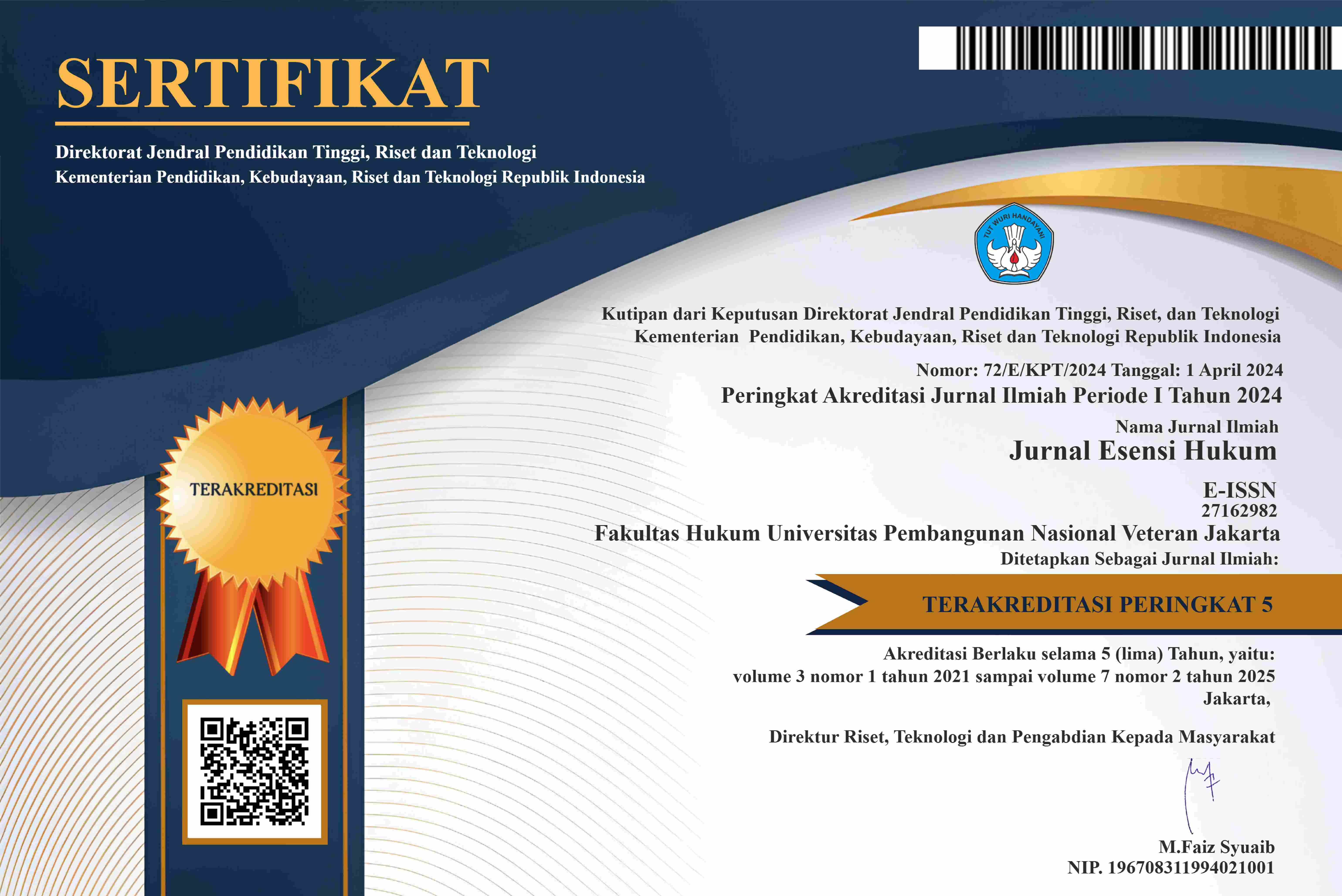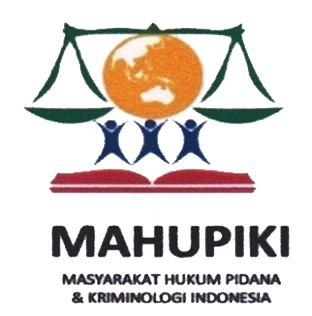ANALISIS YURIDIS PENGELOLAAN BATAS WILAYAH LAUT DAN PESISIR BERDASARKAN UNDANG-UNDANG NOMOR 23 TAHUN 2014 TENTANG PEMERINTAHAN DAERAH
Abstract
Abstract
Indonesia is an archipelagic country with an area of the ocean covering almost two-thirds of the total area of the archipelago which has potential with coastal, oceanic, mineral, oil and natural gas resources, however the boundaries and management of marine and coastal areas are not yet optimal and evenly distributed, especially by the Government. Area. Law Number 23 of 2014 concerning Regional Government has stipulated that the maximum boundary for the provincial sea area is 12 nautical miles, while the limit for regency / municipal marine production is a maximum of 4 miles, if the boundary of the sea area between provinces does not reach the maximum limit, the limit will be divided by the distance equal to the principle of the median line. The division of authority in the management of maritime and coastal boundaries is felt by the regional and central governments. This research is aimed at analyzing the implications of the Regional Government Law on several laws and regulations on marine and fisheries and to find out the ideal division of authority in the management of maritime and coastal boundaries. This study uses a normative juridical methodology approach. This research aims to provide a more detailed explanation regarding policies that regulate aspects of the management of maritime and coastal boundaries as well as the implementation of central, regional and other vertical authorities for the welfare of people in the Sea and Coastal areas. The results of the study can be concluded that the implementation of regional government authority in managing the boundaries of coastal sea areas is the division of concurrent governmental affairs of choice and division of affairs in the marine sector between the Central Government, Provincial Regions and Regency / Cities, especially in the marine and fisheries sector.
Keywords: authority, local government, coast.
Abstrak
Indonesia merupakan negara kepulauan dengan luas wilayah lautan meliputi hampir dua pertiga bagian dari seluruh luas wilayah Nusantara yang memiliki potensial dengan sumber daya pesisir, lautan, mineral, minyak dan gas bumi, namun batas dan pengelolaan wilayah laut dan pesisir belum optimal dan merata khususnya oleh Pemerintah Daerah. Undang-Undang Nomor 23 tahun 2014 tentang Pemerintahan Daerah telah menetapkan bahwa batas maksimal wilayah laut provinsi sejauh 12 mil laut, sedangkan batas bagi hasil kelautan kabupaten/kota maksimal sejauh 4 mil, apabila batas wilayah laut antar provinsi tidak mencapai batas maksimal, maka batas akan dibagi sama jarak dengan prinsip garis tengah (median line). Pembagian kewenangan dalam pengelolaan batas wilayah laut dan pesisir dirasakan oleh pemerintah daerah dan pemerintah pusat. Penelitian ini diarahkan untuk menganalisis implikasi Undang-Undang Pemerintahan Daerah terhadap beberapa peraturan perundang-undangan tentang kelautan dan perikanan serta mengetahui pembagian kewenangan ideal dalam pengelolaan batas wilayah laut dan pesisir. Penelitian ini menggunakan pendekatan metodologi yuridis normatif. Dalam penelitian ini bertujuan untuk memberikan penjelasan lebih terperinci mengenai kebijakan yang mengatur aspek pengelolaan batas wilayah laut dan pesisir serta pelaksanaan kewenangan pusat, daerah dan lembaga vertikal lainnya untuk mensejahterakan masyarakat di wilayah Laut dan Pesisir. Hasil penelitian dapat disimpulkan bahwa pelaksanaan kewenangan pemerintah daerah dalam pengelolaan batas wilayah laut pesisir merupakan pembagian urusan pemerintahan konkuren pilihan dan pembagian urusan bidang Kelautan antara Pemerintah Pusat, Daerah Provinsi dan Daerah Kabupaten/Kota terkhusus pada sektor kelautan dan perikanan.
Downloads
References
A. Buku
Adisasmita, R. (2015). Analisis Pembangunan Wilayah; Kepulauan, Kelautan, Maritim, Terisolasi, Terpencil, Tertinggal, Perbatasan, Pesisir, Pulau – pulau Kecil, Archipelago dan Semeja. Yogyakarta: Graha Ilmu.
Huda, N. (2014). Desentralisasi Asimetris dalam NKRI: Kajian terhadap Daerah Istimewa, Daerah Khusus dan Otonomi Khusus, Bandung: Nusamedia.
Kaho, J.R. (1988). Otonomi Daerah di Negara Republik Indonesia. Jakarta: Raja Grafindo.
Prasetyo, P.S. (2010). Demokrasi di Indonesia, Teori dan Praktik. Yogyakarta: Graha Ilmu
Situmorang, S. (2002). Model Pembagian Urusan Pemerintahan Antara Pemerintah, Provinsi, dan Kabupaten/Kota. Depok: Universitas Indonesia.
Soekanto, S. dan Mamudji, S. (2006) Penelitian Hukum Normatif. Jakarta: Rajagrafindo Persada.
B. Peraturan Perundang-Undangan
Undang-Undang Negara Kemerdekaan Republik Indonesia Tahun 1945
Undang-Undang Nomor 32 Tahun 2004 tentang Pemerintahan Daerah
Undang-Undang Nomor 27 Tahun 2007 tentang Pengelolaan Wilayah Pesisir dan Pulau-Pulau Kecil
Undang-Undang Nomor 1 Tahun 2014 tentang Perubahan atas Undang-Undang Nomor 27 Tahun 2007 tentang Pengelolaan Wilayah Pesisir dan Pulau-Pulau Kecil
Undang-Undang Nomor 23 Tahun 2014 tentang Pemerintahan Daerah
Undang-Undang Nomor 15 Tahun 2019 tentang Perubahan atas Undang-Undang Nomor 12 Tahun 2011 tentang Pembentukan Peraturan Perundang-Undangan
Peraturan Menteri Kelautan dan Perikanan Republik Indonesia Nomor 23/Permen-Kp/2016 Tentang Perencanaan Pengelolaan Wilayah Pesisir dan Pulau-Pulau Kecil
C. Artikel Jurnal
Suharjono, M. (2014). Pembentukan Peraturan Daerah yang Responsif dalam Mendukung Otonomi Daerah. DIH: Jurnal Ilmu Hukum, 10 (19), 21-37.
Authors who publish with this Journal agree to the following terms:
1. Author retain copyright and grant the journal right of first publication with the work simultaneously licensed under a creative commons attribution license that allow others to share the work within an acknowledgement of the work’s authorship and initial publication of this journal.
2. Authors are able to enter into separate, additional contractual arrangement for the non-exclusive distribution of the journal’s published version of the work (e.g. acknowledgement of its initial publication in this journal).
3. Authors are permitted and encouraged to post their work online (e.g. in institutional repositories or on their websites) prior to and during the submission process, as it can lead to productive exchanges, as well as earlier and greater citation of published works.
4. 
This work is licensed under a Creative Commons Attribution-ShareAlike 4.0 International License.






2.png)

